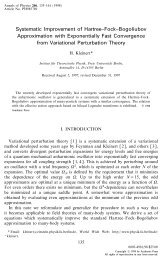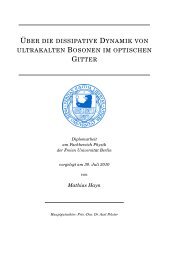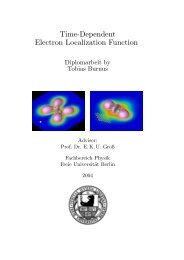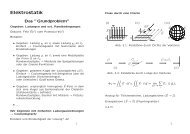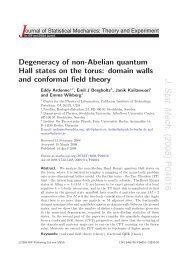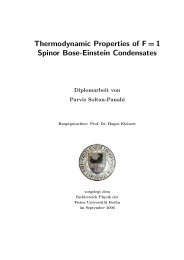Diploma thesis
Diploma thesis
Diploma thesis
You also want an ePaper? Increase the reach of your titles
YUMPU automatically turns print PDFs into web optimized ePapers that Google loves.
3 Complex square well potential<br />
that this changes for intermediate waists c ≈ c crit from m to k or n the states for large dissipation<br />
c ≫ c crit , the states are characterized only by the integer number k or n, which is not clearly<br />
ascribable to a particular m as we just stated.<br />
Here always two ε k I,0-states are fusing for c → ∞ so we denoted them with the same k. These<br />
pairs consist on a k-state starting at some odd m and one starting at one adjoining even m ± 1 so<br />
a symmetric and an antisymmetric state. Moreover we know from Fig. 3.2(a) that it is the state<br />
starting at some odd m which approaches to the state started at some even m. The indeterminacy<br />
of the assignment m ↔ k if ω ≈ ω k,n<br />
crit does not matter since anyhow, if the considered ω is<br />
approximately equal to some critical waist, both possible k-states starting at m or m + 2 yield the<br />
same parity which is opposite to this of the m + 1-state.<br />
It is interesting that all pairs of such fusing k-states have this property that they start at adjoining<br />
values of m for all ω. This is related to the fact that the n-states are ordered by the real part of<br />
the energy and never intersect each other, that means that the real part of states with higher n<br />
run at higher energies than states with smaller n for all c. We already know that the energy, these<br />
real parts run at, decreases for increasing ω so that interchanges with the upcoming real parts of<br />
the k-states occur but the order of the n-states does not change. So after a k-state starting at<br />
some odd m pairing with the k-state starting at m + 1, which is even, has interchanged with some<br />
symmetric n-state, it then starts at m + 2, so the property of pairs m and m ± 1 is still fulfilled.<br />
Because of the order of the n-states the next downcoming n-state is an antisymmetric one, which<br />
interchanges with the other k-state which starts at m + 3 after that and the property is once more<br />
fulfilled. This procedure repeats until all k-states populating the potential well for ω = 0 have<br />
been redistributed to much more higher energies for ω → π until exclusively n-states are present<br />
2<br />
when this limit is reached.<br />
Next we still consider the limit c → ∞. For the imaginary part the limits lim c→∞ ε k I,0 = 0 and<br />
lim c→∞ ε n I,∞ = lim c→∞ (−c) = −∞ seem to be accurate. For the real parts we assume that they<br />
are converging to some finite real number which seems to be plausible since on the one hand it is<br />
implied by the numerical evaluation and on the other hand we know that they are converging for<br />
ω = 0 and ω = π since they are constant in these cases. These should be continuously reached<br />
2<br />
limit cases so the real part should converge for all waists.<br />
So let us make the ansatz lim c→∞ ε k I,0 = 0 and lim c→∞ ε n I,∞ = −c and insert this into the quantization<br />
conditions (3.26) and (3.27) to derive expressions for symmetric and antisymmetric k- and<br />
n-states from these assumptions. Performing this and summing up the results of both (3.26) and<br />
(3.27) provides indeed analytical results:<br />
( ) 2<br />
ε k,sat π<br />
R,0 = k<br />
π<br />
− ω , ε n,sat<br />
2<br />
R,∞ =<br />
(<br />
n π ) 2<br />
. (3.28)<br />
2ω<br />
The results of these equations coincide perfectly with the numerical solutions for large c. They<br />
confirm that for ω = 0 there are only k-states present, since then ε n R,∞ diverges, and for ω = π 2<br />
the k-states are vanishing since then the energy they run at goes to infinity.<br />
They also include the fact that the symmetric k-states tend to the antisymmetric ones as we can<br />
see in Fig 3.2(a), because<br />
lim<br />
ω→0 εk,sat R,0 = (2k) 2 , (3.29)<br />
20




